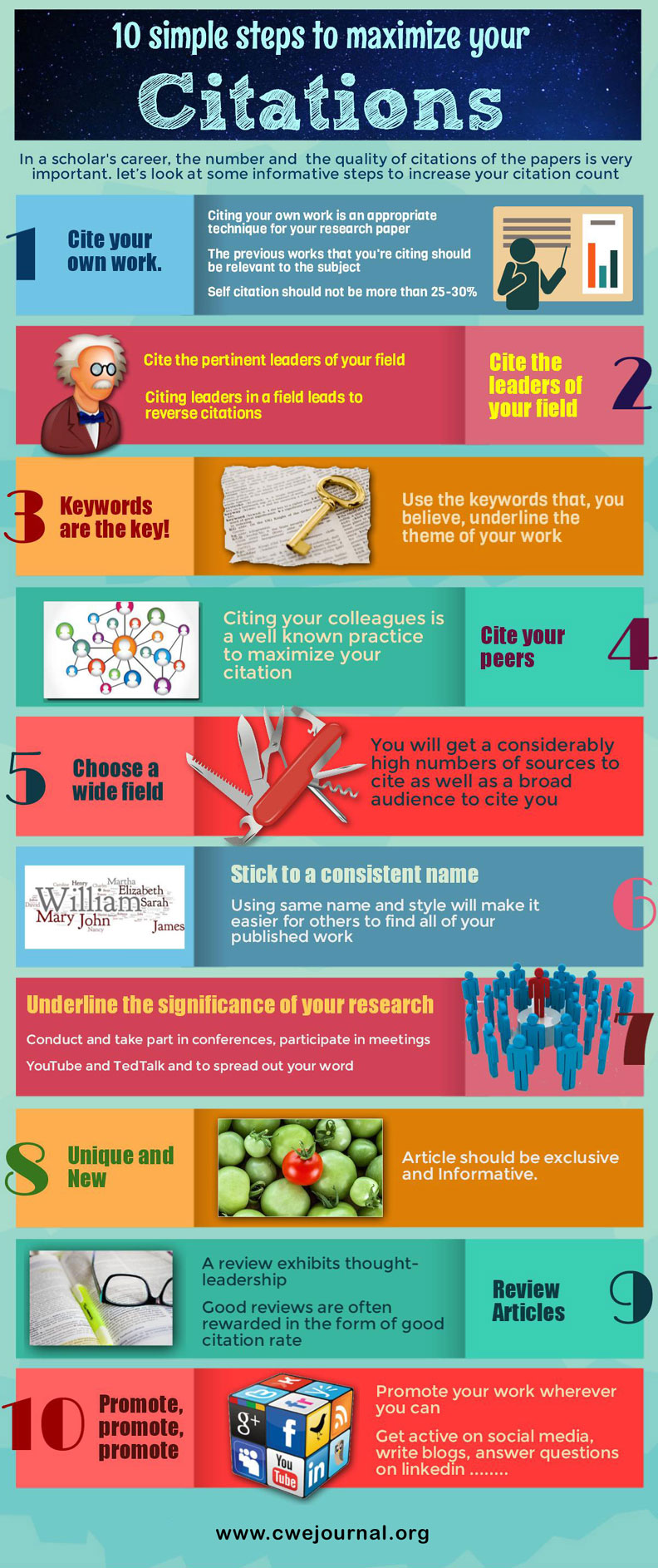10 Simple Steps to Maximize your Citation

Click on the image to download PDF for this info graphics.
In a scholar’s career, the number and more significantly, the quality
of citations of the papers is quite imperative as it is increasingly
being used as an index for promotions, funding and grant reviews. Having
a considerably high amount of citations profoundly displays the impact
your research has on that field.
But maximizing and refining the citation is often looked up as rather
a bane of one’s existence. Well, although the job looks quite tough,
it’s pretty easy. Siding aside the paradox of the previous statement,
let’s look at some informative steps to increase your citation count:
- Cite your own work.
work, citing your own work is a well-thought-out; absolutely appropriate
technique for your research paper. Citing your own work has two
advantages: First, it will act as a profile-raiser for all the work
you’ve done related to that certain subject. Second, it will, of course,
increase your citation count. Nevertheless, two things must be kept in
mind while citing your own wok: First, the previous works that you’re
citing should be relevant to the subject and second, not more than 25-30% of the citations should be of your own work.
- Cite the leaders of your field
that you are well aware of the significant researches of the field, and
thus possess a vital knowledge of the contemporary works of the eminent
names in the field. It also helps to introduce articulate terminology
for new concepts. Citing leaders in a field leads to reverse citations,
which carry more weight.
- Keywords are the key!
authors to select 4-8 keywords (or phrases) to accompany a manuscript.
This is where carefully chosen keywords come into play. Use the keywords
that, you believe, underline the theme of your work and that the
researchers are most likely to be looking up for, so that your paper
will be readily available in database searches.
- Cite your peers
citation count as well as to boost your impression on others of
possessing a great deal of information about the contemporary works and
effects. So cite your colleagues’ works wherever possible. Also,
include in your citations, those colleagues too, whose result is
absolutely contrary to yours.
- Choose a wide field
but if it is possible (or if you are writing your paper as an amateur
researcher), choose a field that is large enough or has very significant
external applications. You will get a considerably high numbers of
sources to cite as well as a broad audience to cite you. Otherwise, your
citations will be limited to people or papers in a small community.
- Stick to a consistent name
unintentionally, different names for different papers. Either they use
their initials on one paper and their full name on the others, or they
opt for a nom de plume for one paper and carry their original name for
the other. Whichever name you wish to use in your papers, stick to it.
Using the same name on all of your papers will make it easier for others
to find all of your published work. And thus, it births more chances of
others to cite you.
- Underline the significance of your research
part in conferences, participate in meetings, offer your lectures for
libraries and such gatherings. Also, use YouTube and TedTalk to spread
out your word. Utilize both institution and publisher press releases.
Most institutions have a public relations division that can help create
and deliver a press release.
- Unique and New
Informative and unique papers often seem to go a long way and create a
firm impact on the field. If your paper ‘teaches’ something new and
beneficial to the other people, they will tend to cite your paper. It’s
one thing just putting together all the data and writing it up and
another being able to ‘communicate’ it to the rest.
- Review
simultaneous idea of revolutionary work regarding a certain research.
It has been broadly observed that good reviews are often rewarded in the
form of good citation rate. These citations translate to higher impact
factors for the journals. Therefore, always consider writing a
tremendous review. It may or may not build up a good career alone but it
will unquestionably lead to a dramatic hype in overall citation count.
- Promote, promote, promote
your paper, even ones not in your field, and email copies of your paper
to researchers who may be interested. Get active on social media. Create
a Facebook page and encourage discussion regarding your research, open a
Twitter account and actively promote the updates about your work, write
blogs about the revolutionary ideas related to your paper. Create a
Linked In account and get in talk with other people worldwide, post
about the conferences and meeting you have attended, ask questions, and
maybe list your publication. Use and Provide a link to your page on
social media. Get involved in it as much as you can.
While citing others, be careful about the names and spellings of
authors and their works, for such carelessness may lead to distaste
towards the author. Never forget to write a vibrant abstract so that
your article is appropriately indexed and easy to find. Give it an
effective title and submit it to the most respected journal.
Adopting various methods to maximize the citation count and citation
rate looks like a difficult job at first, but yields fantastic results.
Watching the citation rate growing high after striving hard for it is
quite rewarding and gratifying in its own way!
Views: 22




10 Simple Steps to Maximize your Citation | Current World Environment
your article is good .i have also a good article you know easily check that How To Prepare Your Academic Papers Faster
ReplyDelete